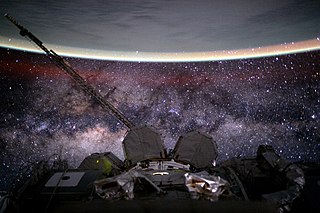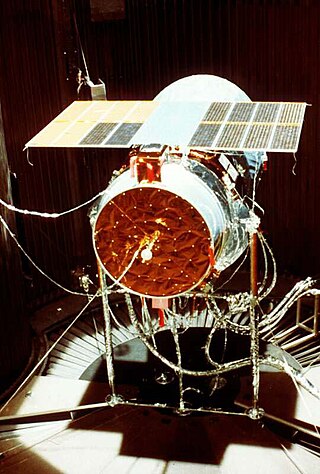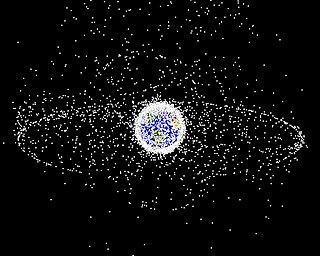Related Research Articles

A low Earth orbit (LEO) is an orbit around Earth with a period of 128 minutes or less and an eccentricity less than 0.25. Most of the artificial objects in outer space are in LEO, peaking in number at an altitude around 800 km (500 mi), while the farthest in LEO, before medium Earth orbit (MEO), have an altitude more than about one-third of the radius of Earth, roughly at the beginning of the inner Van Allen radiation belt.

Space debris are defunct human-made objects in space – principally in Earth orbit – which no longer serve a useful function. These include derelict spacecraft, mission-related debris, and particularly-numerous in-Earth orbit, fragmentation debris from the breakup of derelict rocket bodies and spacecraft. In addition to derelict human-made objects left in orbit, space debris includes fragments from disintegration, erosion, or collisions; solidified liquids expelled from spacecraft; unburned particles from solid rocket motors; and even paint flecks. Space debris represents a risk to spacecraft.

The Infrared Astronomical Satellite (IRAS) was the first space telescope to perform a survey of the entire night sky at infrared wavelengths. Launched on 25 January 1983, its mission lasted ten months. The telescope was a joint project of the United States (NASA), the Netherlands (NIVR), and the United Kingdom (SERC). Over 250,000 infrared sources were observed at 12, 25, 60, and 100 micrometer wavelengths.

Gravity-gradient stabilization or tidal stabilization is a passive method of stabilizing artificial satellites or space tethers in a fixed orientation using only the mass distribution of the orbited body and the gravitational field. The main advantage over using active stabilization with propellants, gyroscopes or reaction wheels is the low use of power and resources. It can also reduce or prevent the risk of propellant contamination of sensitive components.

Long March 5, or Changzheng 5 (CZ-5), and also by its nickname "Pang-Wu", is a Chinese heavy-lift launch vehicle developed by the China Academy of Launch Vehicle Technology (CALT). It is the first Chinese launch vehicle designed to use exclusively non-hypergolic liquid propellants. It is the fifth iteration of the Long March rocket family.

The Kessler syndrome, proposed by NASA scientists Donald J. Kessler and Burton G. Cour-Palais in 1978, is a scenario in which the density of objects in low Earth orbit (LEO) due to space pollution is numerous enough that collisions between objects could cause a cascade in which each collision generates space debris that increases the likelihood of further collisions. In 2009, Kessler wrote that modeling results had concluded that the debris environment was already unstable, "such that any attempt to achieve a growth-free small debris environment by eliminating sources of past debris will likely fail because fragments from future collisions will be generated faster than atmospheric drag will remove them". One implication is that the distribution of debris in orbit could render space activities and the use of satellites in specific orbital ranges difficult for many generations.

In 2015, the maiden spaceflights of the Chinese Long March 6 and Long March 11 launch vehicles took place.

Several new rockets and spaceports began operations in 2016.

Tianhe, officially the Tianhe core module, is the first module to launch of the Tiangong space station. It was launched into orbit on 29 April 2021, as the first launch of the final phase of Tiangong program, part of the China Manned Space Program.

Resurs-P No.1 was a Russian commercial Earth observation satellite capable of acquiring high-resolution imagery. It is one of a series of Resurs-P spacecraft. The spacecraft was operated by Roscosmos as a replacement of the Resurs-DK No.1 satellite until it ceased operations in 2021. In 2024 the satellite broke up, releasing objects into low earth orbit which required the crew of the ISS to take shelter.
Kosmos 2499 was a Russian satellite orbiting the Earth, before breaking up on January 4, 2023.

ATS-4 also known as ATS-D was a communications satellite launched by NASA on August 10, 1968 from Cape Canaveral through an Atlas-Centaur (AC-17) rocket.

ÑuSat satellite series, is a series of Argentinean commercial Earth observation satellites. They form the Aleph-1 constellation, which is designed, built and operated by Satellogic.
The Gravity Gradient Stabilization Experiment (GGSE-1) was a technology satellite launched simultaneously with four other satellites on 11 January 1964 by the U.S. military from Vandenberg Air Force Base aboard a Thor Augmented Delta-Agena D rocket. It demonstrated a new oscillation damping system intended for use in reconnaissance satellites.

Space sustainability aims to maintain the safety and health of the space environment.
References
- ↑ "NASA - NSSDCA - Spacecraft - Details".
- ↑ "No satellite crash: 2 pieces of space junk whiz safely by each other over Pittsburgh". 30 January 2020.
- ↑ "No satellite crash: 2 pieces of space junk whiz safely by each other over Pittsburgh". 30 January 2020.
- ↑ "Two Satellites Could Collide Tonight". 29 January 2020.
- ↑ "Two satellites over Pittsburgh appear to miss after chance for collision".
- ↑ "Looming Potential Satellite Smashup Could Spawn Dangerous Debris Swarm".
- ↑ @LeoLabs_Space (29 January 2020). "Our latest data on the IRAS / GGSE 4 event" (Tweet) – via Twitter.
- ↑ @LeoLabs_Space (29 January 2020). "Our latest update this morning for IRAS / GGSE 4" (Tweet) – via Twitter.
- ↑ "2 satellites will narrowly avoid colliding at 32,800 MPH over Pittsburgh on Wednesday". 28 January 2020.
- ↑ @LeoLabs_Space (29 January 2020). "Adjusted calculations for larger object size" (Tweet) – via Twitter.
- ↑ @juliancd38 (29 January 2020). "Trails of both IRAS and GGSE4 continue unimpeded after intersection" (Tweet) – via Twitter.